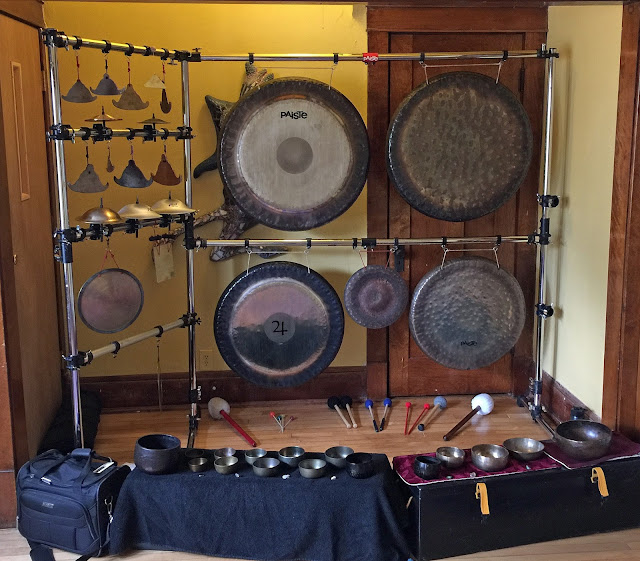Percussion Technique for Non-Percussionists
I've played and studied percussion for over 40 years, so I can't help but bring what I have learned into my playing of Gongs, Bowls, and Bells. Whether I'm performing a concert of my original compositions, or presenting a Gong Meditation session, the idea of drumming technique is always present. In meeting and watching other Gong players, I have found the majority of them with no percussion background or training. To this end, I see many people just flailing away at the Gong with apparently no real idea of what and how they are doing it. In some cases, the resulting sounds are really quite discouraging and awful. I would like to offer some basic tips and exercises to help improve both your playing technique, and the quality of the sound/s you make.
1) When you strike you Gong/Bowl/Bell, is it a pleasing sound? Is it musical? You need to listen to the sounds you make and not just strike the instruments with no regard for the resulting sound. Now people may have differing opinions on what a good sound is, but I would challenge everyone, that in the context of playing the Gong/Bowl/Bell for a meditation or sound therapy session, the goal is to produce a pleasing, musical sound. You would be surprised at the sounds I have heard, both live and on videos, that are truly nothing more than irritating! And by watching the performer, it would appear that they have little or no clue/regard to what a good sound is like. Don't just hit something. LISTEN to the sound you make. And if it doesn't sound good, change your approach/technique to create a better sound.
2) Practice, practice, practice! Don't just play at your sessions. You need to spend time at your home/studio playing by yourself. When you practice, again, listen to the sound you make. Also, pay attention to how and where you strike your instrument. How does the sound change? Pay attention to how striking with a different force will change the sound. There are so many different sounds and tonalities available on the Gong. You need to know where they are and how to produce them. This is no different than playing piano, trumpet, violin, or any other instrument.
3) Here are some basic exercises to work with. You can play them various ways.
You can also watch my earlier series, Working With Gongs - Series 1
As for Singing Bowls and Bells, they are more one dimensional in sound than Gongs, but you still need to work with them to learn how to bring out the sounds you want. You can also use the above exercises with them. Remember to try different mallets/wands to bring out different sounds/tones.
With some serious work, you will be able to create a better sound experience for both yourself and others.
~ MB
1) When you strike you Gong/Bowl/Bell, is it a pleasing sound? Is it musical? You need to listen to the sounds you make and not just strike the instruments with no regard for the resulting sound. Now people may have differing opinions on what a good sound is, but I would challenge everyone, that in the context of playing the Gong/Bowl/Bell for a meditation or sound therapy session, the goal is to produce a pleasing, musical sound. You would be surprised at the sounds I have heard, both live and on videos, that are truly nothing more than irritating! And by watching the performer, it would appear that they have little or no clue/regard to what a good sound is like. Don't just hit something. LISTEN to the sound you make. And if it doesn't sound good, change your approach/technique to create a better sound.
2) Practice, practice, practice! Don't just play at your sessions. You need to spend time at your home/studio playing by yourself. When you practice, again, listen to the sound you make. Also, pay attention to how and where you strike your instrument. How does the sound change? Pay attention to how striking with a different force will change the sound. There are so many different sounds and tonalities available on the Gong. You need to know where they are and how to produce them. This is no different than playing piano, trumpet, violin, or any other instrument.
3) Here are some basic exercises to work with. You can play them various ways.
Play: R R R R etc, or L L L L etc.
(R=right hand, L=left hand)
- Play just in the center of your Gong. Try to produce a full, rounded sound. You don't want it to be choked at all.
- Play the same thing between the center and the edge. Notice the sound difference.
- Play the same thing again, but near the edge. Notice the sound difference.
- Play the same thing, but move back and forth from the center to the edge. Notice how the sound changes as you move to a different place on the face of the Gong. Right hand moves from center to right edge, left hand moves from center to left edge.
- Vary the speed/tempo that you play these strokes at. Keep them steady and even.
- Make sure your strokes are even: the same force, the same distance from the Gong.
- The goal is to be able to reproduce whatever sound you want at any time.
If you have a pair of identical mallets, then work through the same exercises playing this,
PLAY: R L R L etc, or L R L R etc.
For further examples/ideas, you can watch my 6-part video series, Working with Gongs - Series 2
With some serious work, you will be able to create a better sound experience for both yourself and others.
~ MB
Chop Wood | Carry Water | Play Gongs



Comments
Post a Comment